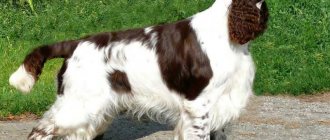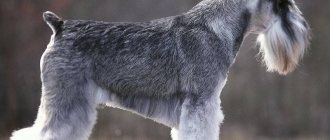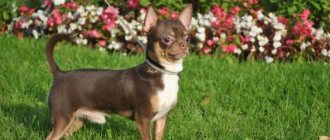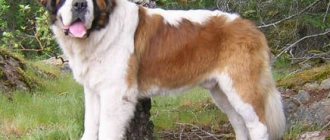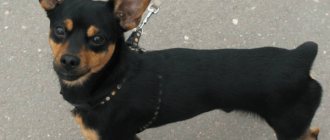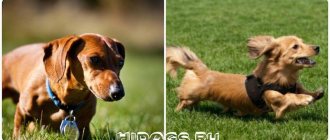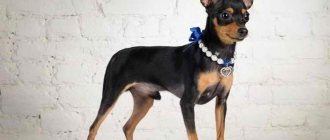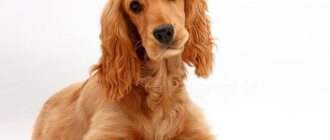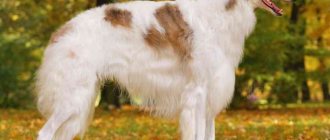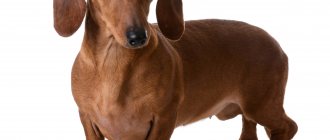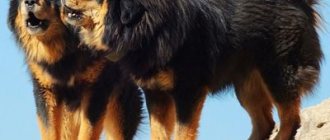The emergence and development of the breed
The Miniature Schnauzer breed was developed in Germany in the 19th century. It was assumed that these dogs would guard livestock and hunt rats.
By the end of the 19th century, the breed began to gain popularity all over the world, by the middle of the 20th century it became one of the most popular in the world, and in the mid-70s it was imported into the USSR.
Description
When you look at a miniature schnauzer for the first time, you simply cannot determine whether it is a couch dog or not. This is a very elegant and miniature pet, and at the same time, its appearance lacks glamor and dwarf decorativeness.
This breed is a real guard dog and is absolutely not inferior to other representatives in this matter.
Exhibition figures
The description of the Miniature Schnauzer according to international standards suggests the following characteristics of the breed:
- Height no more than 35 cm at the withers.
- Weight no more than 7 kg and no less than 4.5.
- The fur is long everywhere except the forehead and ears, on the limbs it is softer than on the rest of the body, and there is a “beard” at the bottom of the muzzle.
- The head is large, with a gradual narrowing and scissor-shaped jaws.
- The tail is set high.
- The shape of the paws is round, they themselves are short, with dark claws.
- black;
- white;
- black with silver;
- pepper and salt;
- chocolate and tan (exists only in Russia, not yet recognized by FCI standards).
Chocolate and tan miniature schnauzers are allowed for breeding and some international exhibitions.
General information and History of the breed
The predecessors of the Miniature Schnauzer were the Miniature Schnauzer, but breeders sought to develop a smaller Schnauzer that could become a problem-free daily companion. So the selection followed the path of crossing with Spitz dogs and poodles. This is how the first representatives of the breed were formed, who later provided their gene pool for the formation of the breed.
INTERESTING: the breed standard was approved in 1888 and is valid to this day.
For our country, the miniature breed became known in the 80s of the last century and immediately attracted the attention of dog breeders. Almost immediately, breeding kennels were registered in the USSR, and at exhibitions miniature schnauzers became regular participants in the rings.
Exterior and characteristics of the breed
The Miniature Schnauzer has many similarities with its larger brothers in the breed line, but still has a number of traits due to which it was identified as a separate breed.
The height at the withers varies from 30 to 35 centimeters. Bitches are not very different from males, since the breed is miniature. But the males are still stockier. The weight of an adult miniature schnauzer should not exceed 7 kg, overweight is not typical, the dog should look lean in accordance with the purpose of the breed. Life expectancy is typical for small dogs and ranges from 12 to 15 years.
Thanks to German breeders, the miniature schnauzer turned out to be a strong dog with a muscular body and a serious expression on its face. His shaggy eyebrows draw a menacing grimace, but coupled with their miniature size, the appearance of miniatures evokes a smile rather than fear. The peculiarity of the structure of the representatives of the breed is such that they can develop high speed when running, and the general exterior of the dog is expressed in the harmonious structure of the whole body, which is rare for dogs of forced selection towards reduction in size.
The structure of the skull and teeth is almost perfect, the ears are set high and slightly curved at the tips. Eyes, according to the standard, must be dark in color and almond-shaped. The coat of the Miniature Schnauzer breed is hard, short on the body and long on the muzzle, thick and with a dense undercoat.
The classic color for the breed is “salt and pepper,” which is allowed in gradations from dark gray to silver gray. This is also the most common color of miniatures. Less common are black, white and chocolate-tan, but the latter two are not recognized by all canine organizations.
IMPORTANT: for any coat color, a dark mask on the dog’s face is required.
The following are considered unacceptable exterior features:
- Sharp or oval skull shape,
- Direct bite and protruding cheekbones,
- Light eyes,
- Hare's navel tail
- Elongated limbs (this is not a giraffe),
- Soft wool, tendency to curl,
- Chocolate color,
- Bitch with a male build.
All of the above characteristics impose restrictions on further participation in the breeding and exhibition process, but if there are no mental complications, and you do not strive to become a breeder, then feel free to take a miniature schnauzer as your companion.
Character and habits
You don't have to be an experienced dog breeder to own a dog like a miniature schnauzer. An inquisitive mind allows the breed to learn quickly, which is important if you have never raised a dog before. It is believed that miniature dogs are universal dogs; they are suitable for hunting, guard duty, as companion dogs and nannies. Also, the breed’s energy and harmonious movements are highly valued by breeders who are interested in dog sports.
Since childhood, miniature schnauzers have become very attached to their owner. They consider children to be part of the owner’s property, which needs to be entertained and protected. So you can safely let your children walk your pet, because they will play together, and if necessary, the dog will protect its little companion.
The Miniature Schnauzer dog is also universal in that it can be kept both in a private home and in a city apartment. Dedicate enough time to playing together with your dog and he will behave well in your absence at home during the day, because he will accumulate strength for the evening, when the owner comes and you can give all of yourself and your energy to him.
INTERESTING: thanks to the fearlessness and intuition inherent in the breed, miniature schnauzers are often hired to serve in the police and customs.
Today, loyal, always cheerful and smart miniatures are among the top 10 most popular breeds. Of course, in the modern world the rating is greatly influenced by the fashion for miniature breeds, but in the case of the miniature schnauzer, its character plays a big role.
IMPORTANT: the breed does not get along with cats at all, but is ready to partially perform their functions. So, living in a private house, your miniature schnauzer can begin to hunt mice, rats and moles that come across it on the territory.
If you are getting this breed in a private home, then you should provide entertainment for the dog on the site. Equip your pet with a small sports corner with obstacles. This will be useful both for independent games in the warm season in the yard, and for training in preparation for exhibitions.
Character
A miniature schnauzer is by no means a lap dog! This is a very smart, brave and active dog that will regularly test its owner’s strength.
Therefore, you need to pay great attention to his training - without this, miniature schnauzers behave poorly.
But a well-trained dog will flawlessly perform any service entrusted to him, guard the house, warning of strangers by barking.
Many of them are used to fight drug couriers at airports.
Features of mittels
Dogs of this breed are considered very worthy pets, having a strong attachment to their owner and his family members. However, sometimes an arrogant pet will still have to be reminded who is boss.
Mittels are very active and long walks and active physical activity are vital for them. A person planning to get a pet must realistically assess his capabilities in order to provide the dog with decent maintenance.
The dog will definitely need to undergo OKD and other types of training. They are very smart, but often cheat or lose interest in the learning process. In this case, they will have to be encouraged and stimulated with something.
They get along well with small animals if they grew up together or ended up in a house where there was already an adult animal. In other cases, they may open a hunt, since the rat-catcher instinct is present in all breeders.
Content Features
The Miniature Schnauzer is a dog that requires a lot of activity. He needs an active owner who has the opportunity to walk with him several hours a day, run and play.
It’s even better if you have the opportunity to take him to nature. There the miniature schnauzer feels great and usually settles into the surrounding area with interest.
Purchasing a miniature schnauzer: what to look for
When choosing a puppy, you need to pay attention to:
- the color of not only the coat, but also the skin (if it is whitish, the undercoat may develop a color that does not meet the standards);
- body and head shape (without signs of dwarfism);
- behavior should be active, cheerful, without aggression or cowardice
It is also necessary to monitor the general conditions of the breeder.
Grooming
The Miniature Schnauzer needs to regularly:
- Comb out (at least once every 2 days).
- Rub with a towel (after walking in the rain).
- Wash with shampoo (2-3 times a year).
- Wipe his beard (after eating).
- Pluck dead fur after shedding.
- Cut.
This will allow you to maintain the most beautiful and standard-compliant appearance.
Maintenance and care
It is no secret that a well-groomed, beautiful and healthy dog is entirely the merit of its owner. The Miniature Schnauzer breed, among other things, is a hairdresser and requires special care for its coat. Regular trimming will be required, as well as a special haircut to give the dog a pedigree appearance, such as that shown by many miniature schnauzers in the photo.
Again, thanks to its miniature size, even an inexperienced owner can master proper coat care. You can learn trimming yourself using training videos on the Internet or from the breeder who sold the dog. It is best to entrust the first procedure to a specialist who will show you how to process miniature schnauzer fur and basic techniques.
You will also need to periodically pluck hair from the ears, wash and dry the beard after feeding, monitor the condition of the eyes and do not skip preventive vaccinations.
For bathing, you can use special shampoos from the series for hard wool or regular tar soap. If you often walk on grass, bushes and snow, then the top layer of wool should be treated with oil balms, which will protect the coat from abrasion and drying out.
Training
- Training is very important when dealing with a Miniature Schnauzer! The most important period is the first six months of a puppy’s life.
- During this period, he remembers most of the commands and prohibitions, as well as all the boundaries of acceptable behavior.
- You should not allow your Miniature Schnauzer puppy to bark in vain or be aggressive towards people.
- You cannot beat a dog or intimidate it - you can communicate with it only under the condition of mutual respect and authority of the owner.
- After strengthening the primary skills, you can gradually socialize the dog.
- The optimal solution here is a trip to a dog handler.
Health problems
These dogs are less prone to diseases. They may have problems with
- allergies;
- melanoma formation;
- thyroid function;
- eye diseases.
You should also pay attention to the diet - obesity is common in this breed.
Care
Before you get a puppy of this breed, you need to carefully prepare your home for his arrival: miniature kids will definitely be naughty and mischievous. It is necessary to remove decorative items, shoes, clothes, flowers, and household chemicals higher up. Make sure that the dog cannot reach the electrical wires. And still, these measures are not enough. In the first months of life in a new place, it is better to limit the puppy’s movement to one room and take it into the kitchen only for feeding.
- Hair matting and tangles are a real problem for the breed. A small dog should be brushed at least once a week. The process usually starts with the paws. All folds and problem areas are combed out: armpits, stomach, fingers.
- You should wash the miniature immediately before cutting or when it gets dirty. These dogs do not need frequent bathing. Be careful with shampoo: do not allow the product to get on the mucous membranes. You need to rinse the shampoo off your body as thoroughly as possible.
- The ears need to be checked more often for infections. Symptoms will include redness and discharge. If the dog's ears are not cropped, the likelihood of otitis increases due to lack of ventilation.
Show dogs require trimming - plucking of hair and undercoat throughout the body, with the exception of certain areas. It is problematic for inexperienced owners to carry out such a procedure themselves - it is quite difficult and takes a lot of time. Specialized grooming salons can help.
If the miniature schnauzer is a family dog that does not take part in shows, everything is simplified: for such animals a regular haircut down to the undercoat is sufficient. You can do this procedure yourself or use the services of a groomer.
Miniatures are unpretentious in food and are not prone to overeating. If a dog eats dry food, it should be premium, containing energy-intensive additives. Dry food should be optimized for small breeds that are active.
Natural feeding will also suit the miniature dog, but you don’t need to mix food with dry food: it’s either one or the other. The basis of a natural diet should be chicken and beef, with the addition of cereals and vegetables.
You will have to walk your miniature schnauzer at least three times a day, regardless of weather conditions. The walk should be active. These dogs are ardent supporters of the regime: if the temptation arises to skip a walk, the dog will definitely remind you of it, showing serious persistence.
